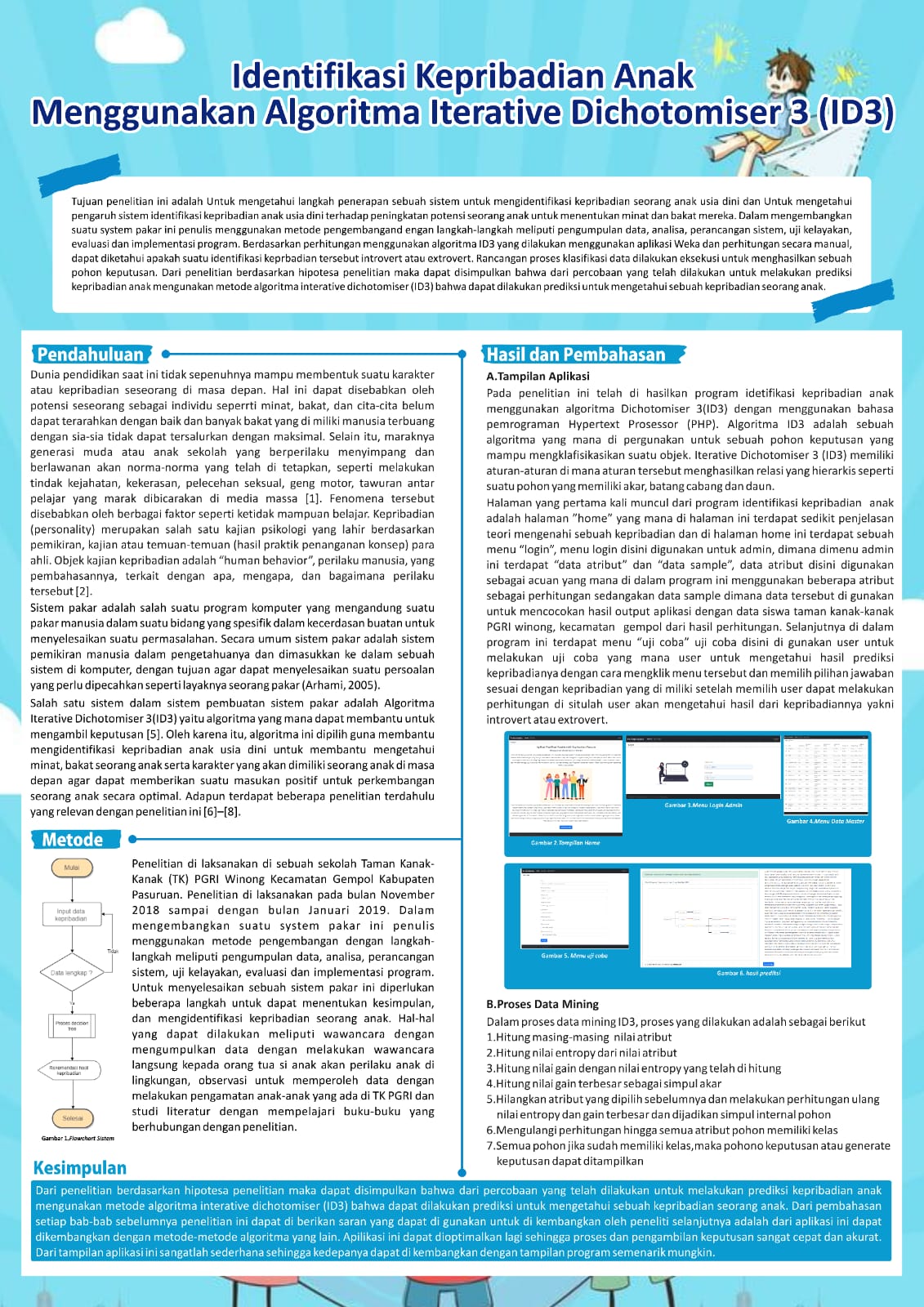Identification of Children's Personality Using Iterative Dichotomizer 3 (ID3) Algorithm
Identifikasi Kepribadian Anak Menggunakan Algoritma Iterative Dichotomiser 3 (ID3)
DOI:
https://doi.org/10.21070/pels.v4i0.1420Keywords:
Early Childhood, Decision Tree, Expert System, ID3 Algorithm, Personality Identification SystemAbstract
The purpose of this study was to determine the steps of implementing a system to identify the personality of an early childhood and to determine the effect of an early childhood personality identification system on increasing a child's potential to determine their interests and talents. In developing an expert system, the authors use the development method with steps including data collection, analysis, system design, due diligence, program evaluation and implementation. Based on calculations using the ID3 algorithm using the Weka application and manual calculations, it can be seen whether a personality identification is introverted or extroverted. The design of the data classification process is executed to produce a decision tree. From the research based on the research hypothesis, it can be concluded that from the experiments that have been carried out to predict a child's personality using the interactive dichotomous algorithm (ID3) method, predictions can be made to find out a child's personality.
Downloads
References
M. Iqbal, “Penanggulangan Perilaku Menyimpang (Studi Kasus SMA Negeri 1 Pomalaa Kab. Kolaka Sulawesi Tenggara),” Jurnal Ilmu Tarbiyah dan Keguruan, vol. 17, no. 2, pp. 229–242, 2014.
M. Kusmayadi, “Profil Kepribadian Siswa Berprestasi Unggul dan Ashor berdasarkan Program Studi,” UIN Malang, 2001.
B. S. D. , P. Oetomo, Perencanaan dan Pembangunan Sistem Informasi. Yogyakarta: Andi, 2004.
Marimin, Teknik dan Aplikasi Pengambil Keputusan Kriteria Majemuk. Jakarta: PT.Gramedia Widiasarana Indonesia, 2004.
J. R. Quinlan., “Induction of Decision Trees,” Mach Learn, pp. 81–106.
A. Firlando, “Sistem Pakar Untuk Mengetahui Kepribadian Mental Seseorang (Gangguan Psikologis) Menggunakan Metode Forward Chaining Berbasis Web,” Jurnal Teknik Informatika Universitas Muhammadiyah Sidoarjo, 2015.
D. P. Indah, Anton, and U. Radiyah, “Sistem Pakar Deteksi Karakteristik Dan Kepribadian Diri Menggunakan Metode Forward Chaining,” JIMP-Jurnal Informatika Merdeka Pasuruan, vol. 3, no. 1, 2018.
N. A. Putri, “Sistem Pakar untuk Mengidentifikasi Kepribadian Siswa Menggunakan Metode Certainty Factor dalam Mendukung Pendekatan Guru,” INTECOMS: Journal of Information Technology and Computer Science, vol. 1, no. 1, pp. 78–90, Mar. 2018, doi: 10.31539/intecoms.v1i1.164.
I. Kurniawati, “Komparasi Metode Machine Learning Pada Prediksi Kelulusan Mahasiswa Senamika View project,” 2018. [Online]. Available: https://www.researchgate.net/publication/332874818
C. G. Jung, Psychology and Religion (Psikologi dan Agama). Yogyakarta: IRCiSoD, 2017.
H. J. , S. D. F. F. Eysenck, Encyclopedia of Psychology 2. New York: Harder & Harder, 1972.




